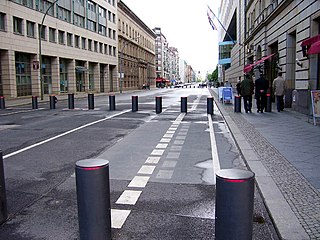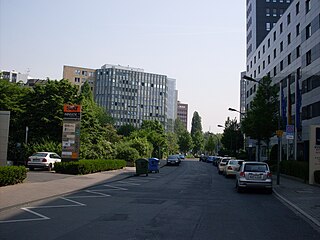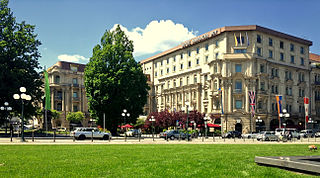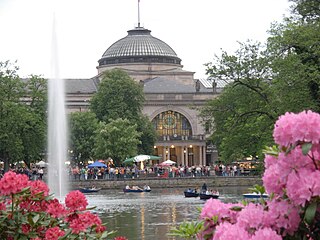
Wiesbaden is a city in central western Germany and the capital of the state of Hesse. As of June 2020, it had 290,955 inhabitants, plus approximately 21,000 United States citizens. The Wiesbaden urban area is home to approximately 560,000 people. Wiesbaden is the second-largest city in Hesse after Frankfurt am Main.

Mamaia is a resort on the Romanian Black Sea shore and a district of Constanța.

The Reich Chancellery was the traditional name of the office of the Chancellor of Germany in the period of the German Reich from 1878 to 1945. The Chancellery's seat, selected and prepared since 1875, was the former city palace of Prince Antoni Radziwiłł (1775–1833) on Wilhelmstraße in Berlin. Both the palace and a new Reich Chancellery building were seriously damaged during World War II and subsequently demolished.

Wilhelmstrasse is a major thoroughfare in the central Mitte and Kreuzberg districts of Berlin, Germany. Until 1945, it was recognised as the centre of the government, first of the Kingdom of Prussia, later of the unified German Reich, housing in particular the Reich Chancellery and the Foreign Office. The street's name was thus also frequently used as a metonym for overall German governmental administration: much as the term "Whitehall" is often used to signify the British governmental administration as a whole. In English, "the Wilhelmstrasse" usually referred to the German Foreign Office.

Shuswap Lake Marine Provincial Park is a provincial park in British Columbia, Canada, comprising 894 ha. The Park has a variety of amenities including boat launch ramps, picnic areas, and 27 campsites around the perimeter of Shuswap Lake. The lake's name and that of the surrounding Shuswap Country is from the Shuswap people (Secwepemc), the most northern of the Salishan speaking people.

Lörick is an urban borough of Düsseldorf, Germany. It is located on the left side of the river Rhine, bordering to the river, Niederkassel, Heerdt and Meerbusch. Lörick was a small village belonging to the office of Heerdt until there was a connection via the Oberkassel Bridge to Düsseldorf in 1898. In 1909 Lörick became, together with Heerdt, a part of Düsseldorf.

Sarıçoban is a village in the Agdam Rayon of Azerbaijan. The village forms part of the municipality of Xındırıstan.

Micharzewo is a village in the administrative district of Gmina Wągrowiec, within Wągrowiec County, Greater Poland Voivodeship, in west-central Poland. It lies approximately 6 kilometres (4 mi) north-east of Wągrowiec and 54 km (34 mi) north-east of the regional capital Poznań.
The Rieterpark is a park in central Zurich, Switzerland. Richard Wagner lived at Villa Wesendonck in Reiterpark from 1849 to 1858 where he worked on Tristan.

Muzeum Więzienia "Pawiak" is a museum in Warsaw, Poland, established in 1965. It shows the history of Pawiak Prison which was notably used during the German occupation between 1939 and 1944.

The Vorbunker was an underground concrete structure originally intended to be a temporary air-raid shelter for Adolf Hitler and his guards and servants. It was located behind the large reception hall that was added onto the old Reich Chancellery, in Berlin, Germany, in 1936. The bunker was officially called the "Reich Chancellery Air-Raid Shelter" until 1943, when the complex was expanded with the addition of the Führerbunker, located one level below. On 16 January 1945, Hitler moved into the Führerbunker. He was joined by his senior staff, including Martin Bormann. Later, Eva Braun and Joseph Goebbels moved into the Führerbunker while Magda Goebbels and their six children took residence in the upper Vorbunker. The Goebbels family lived in the Vorbunker until their deaths on 1 May 1945.

Heerstraße runs from Theodor-Heuss-Platz in Berlin-Charlottenburg to the western city border of Berlin in the locality of Staaken in the borough of Spandau. It is part of Bundesstraße 5; from Theodor-Heuss-Platz to Wilhelmstraße it is forms part of Bundesstraße 2. With a length of around 10 kilometres, it is one of the longest streets in Berlin and an important commuter route. The street is a five-lane expressway (Kraftfahrstraße), depending on traffic flow the middle lane is available during rush hours in the morning (eastbound) and in the evening (westbound).

The Wilhemstraße is an urban boulevard in Wiesbaden, state capital of Hesse, Germany. Nicknamed Rue by the locals, the Wilhelmstraße is one of Germany's busiest, upscale shopping streets.

Nassauer Hof is a luxury five-star superior hotel in Wiesbaden, Germany, and member of the international association The Leading Hotels of the World as well as the German association Selektion Deutscher Luxushotels. The property was built in 1813 and is situated across from the Wiesbaden Kurhaus and at the end of Wiesbaden's luxury shopping avenue Wilhelmstrasse.

The Kurhaus is the spa house in Wiesbaden, the capital of Hesse, Germany. It serves as the city's convention centre, and the social center of the spa town. In addition to a large and a smaller hall, it houses a restaurant and the Wiesbaden Casino, or Spielbank, which is notable for allowing the "highest roulette stakes in Germany", and where Fyodor Dostoyevsky was said to have received the inspiration for his novel The Gambler.

The New Town Hall is a town hall on the Schlossplatz in Wiesbaden, Hesse, Germany. It hosts the city government including the city council, offices of the mayors and part of the administration. It was built between 1884 and 1887 by Georg von Hauberrisser in a Renaissance Revival architecture style. The basement is almost completely occupied by a restaurant called Ratskeller.

The Kurpark, German for "Spa Park", is a public park in the centre of Wiesbaden, Germany, stretching from the Wilhelmstraße to the southern borders of the district of Sonneberg and lying immediately behind the Kurhaus convention center. It was created in 1852 as an English landscape park and includes a lake where boats can be rented, and a 6 metres (20 ft) tall fountain. It has been described as the most beautiful park in Wiesbaden.

The Bowling Green is a park in the Hessian state capital of Wiesbaden.

The Wilhelmstraßenfest is an annual street festival in Wiesbaden, Germany, which began in 1977 in celebration for the reopening of the Hessian state theatre. With roughly 250,000 visitors attending on the two festival days, it is the largest street festival in Germany. It takes place annually during the second weekend of June, on Friday and Saturday, on the namesake Wilhelmstraße and in the adjacent parks of Bowling Green and Warmer Damm. Its official name is "Theatrium." The name "Theatrium" is derived from then from "theater" and "Atrium". The festival offers the largest outdoor event in the city, a variety of culinary specialties, and many music show performances, up to seven large and small stages, rides, a craft market with 130 exhibitors, and a grand finale: a fireworks show.

The Reich President's Palace was from 1919 to 1934 an official residence of the President of the Reich and the official seat of the German head of state.

























